First impressions: How does 778hp Case Quadtrac shape up?
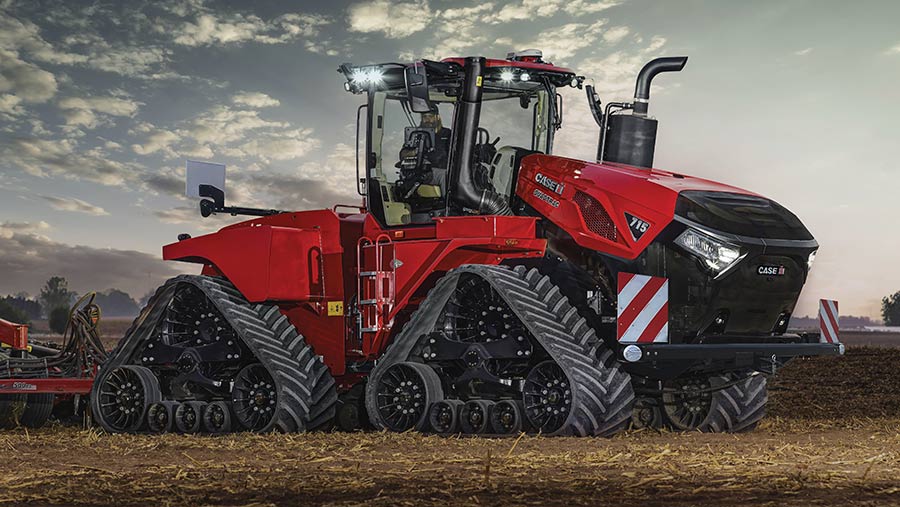 Quadtrac 715 © Case IH
Quadtrac 715 © Case IH When any tractor manufacturer brings its new, most powerful production tractor to the market, it’s bound to stir excitement among farm machinery enthusiasts.
At a recent field day near Fuchsenbigl, one hour east of the Austrian capital Vienna, Case IH offered a first look at its latest Quadtrac, which tops out at a heady 778hp – 79hp more than the recently launched 645 (itself a replacement for the old 620).
See also: Ultimate guide to buying a tractor 2023
The firm believes the 715 will find favour with European businesses already running a 620, particularly where heavy soils and rolling terrain push the machines to their limits during tillage operations.
However, the most fervent demand will come from large arable units in Eastern Europe and the high-horsepower hotbeds of North America, Australia and South Africa, where there is little sign of the demand for outright pulling power waning.
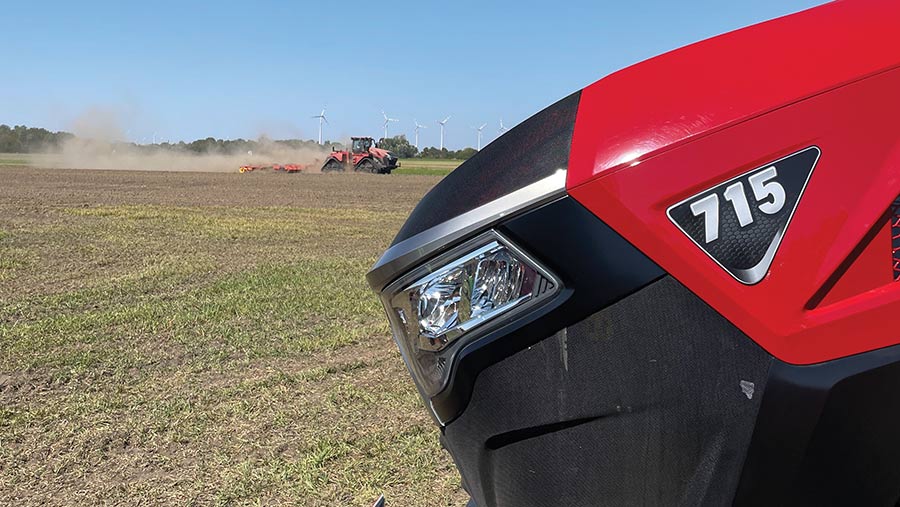
© Adam Clarke
Nose job
Running through the updates on the new 715, the most obvious change is the machine’s ultramodern bonnet design, which has replaced the relatively low-key nose of previous Quadtrac models.
Fresh tinwork isn’t the only difference out front, with the bonnet now opening electronically via a switch near the cab steps.
It can raise to an angle of 34deg, rather than the previous 26deg, to give fitters and operators much better service access around the engine and cooling systems.
Underneath, the 715’s extra power is generated by a new FPT Cursor 16-litre TST, which has a displacement 23% greater than the 645’s 13-litre unit.
Its maximum output of 778hp is reached at 1,900rpm and peak torque of 3,255Nm comes at a lowly 1,400rpm.
High torque availability is ensured with a twin-stage intercooled turbocharging system that is said to guarantee fast load response in tough conditions.
Wider saddle tanks on the back of the frame hold a total of 1,968 litres of diesel, 11% up on the 645, which should also reduce the frequency of refuelling stops.
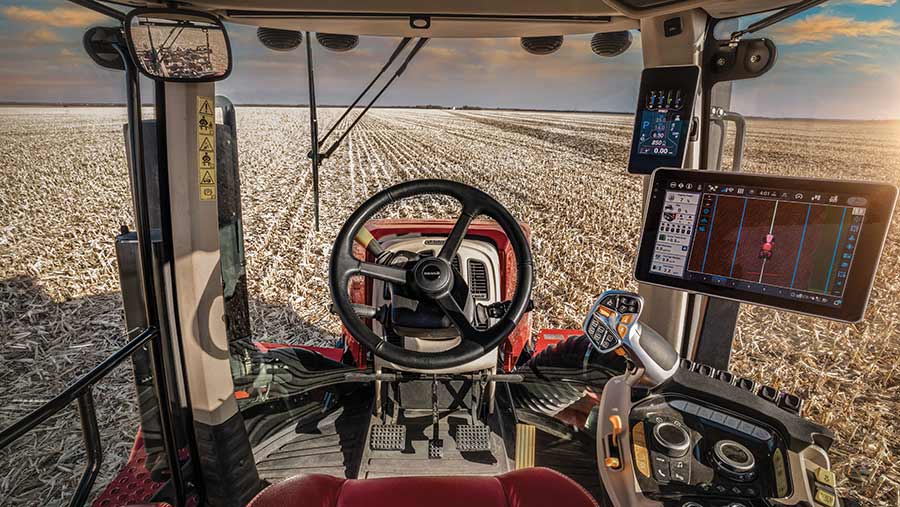
© Case-IH
Driveline upgrades
That additional power has necessitated several other upgrades, including a beefier version of Case’s 16-speed powershift transmission and a stronger driveline to transfer power to the four tracks.
These are 305mm longer, ostensibly to provide greater ground contact, enhanced power transfer and traction, and reduced soil compaction.
Drive wheel diameter has also increased from 910mm to 1,008mm, which means five track lugs are permanently pinned to terra firma, rather than four, primarily to better handle the extra torque and help extend track life.
Jumping on the 715 for a first drive, access is via staircase-style rotating steps.
New grab rails are conspicuously wrapped around the top, something that should make the wiping down of dusty and dirty windows or mirrors much safer.
From the seat, workspace updates are not immediately obvious – but they are there.
These include LED lighting in the headlining and, if selected from the options list, a subwoofer and additional tweaker speakers in the cab posts.
There are also new storage areas and an integrated rail system on the right-hand side that makes it easy to attach a second AFS Pro Terminal if necessary.
The 715’s lights have been redesigned too, with LED road and work lights producing an output of 25,420 lumens. For context, that’s some 11% more illumination power than previous models.
Smooth ride
A few passes with a 6m Vaderstad Carrier certainly wasn’t enough to put the 715 under any strain, but the driver position and visibility feels second to none and the ride is as smooth as you’d expect from a flagship Quadtrac with four-point cab suspension.
But, metaphorically speaking, will the 715’s ride be as smooth on its journey into the UK market?
Franz Josef Silber, Case IH’s product marketing manager for high-horsepower tractors, says the company does not expect all current 620 Quadtrac owners to make the jump to a 715.
However, he believes the increase in power and efficiency will appeal to those performing primary cultivations on more challenging terrain.
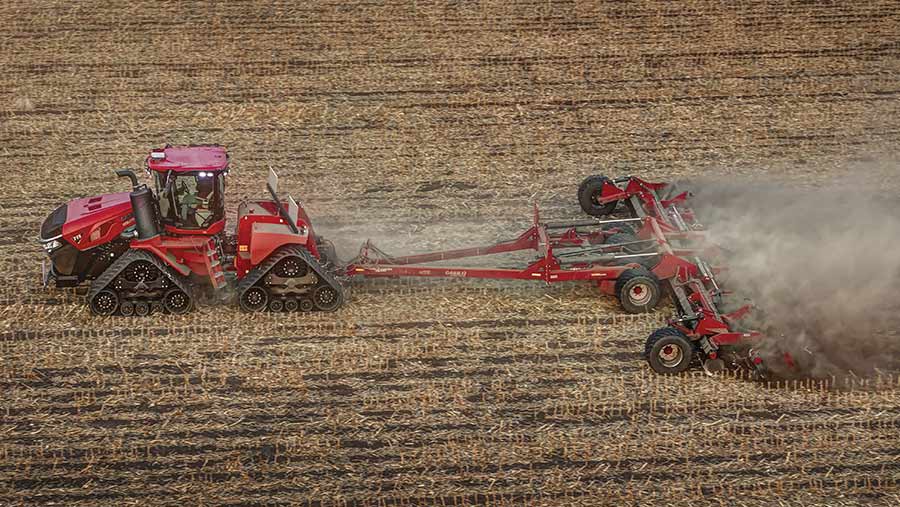
© Case-IH
He also counters the argument that increasingly heavier kit is always detrimental to soil health and points out that a machine such as the 715 with the capacity to pull wider implements can cover more ground in fewer passes.
This allows operators to make the most of narrow working windows, when soil conditions are most suitable for traffic.
Soils and machinery expert Philip Wright agrees with that sentiment, but only to a certain degree.
Big arable units with fields capable of accommodating the widest kit can traffic less area and therefore minimise any detrimental effect on soil structure.
With GPS and controlled-traffic farming (CTF) systems, wheelings can also be kept in the same place and compaction taken out with targeted loosening operations when time and conditions allow.
Furthermore, weight distribution on a four-track machine is much better than with twin-track options such as a John Deere 9RT, resulting in less slip, smearing and surface compaction of soil – especially when making turns.
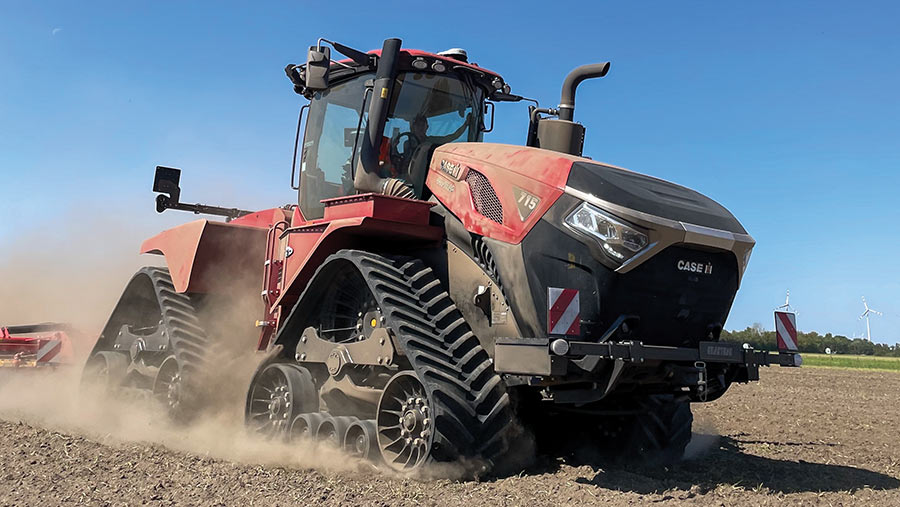
© Adam Clarke
Weight and power
However, the more power you have, the greater the tractor weight needs to be to get that to the ground, so there could still be an unnecessary effect on the soil structure, particularly at depth.
If possible, Philip says it would be better to use this power through forward speed as opposed to just increased drawbar pull – meaning wider and potentially lower draft kit can be a better move if sticking with big tractors such as the 715.
But over recent years he has seen ever larger tractors and implements contribute to poorer soil structure as growers strive for efficiency, particularly on headland turns or when working on soil types with a high risk of compaction.
This requires deeper remedial action, and loosened soil is then at greater risk of structural damage if worked at the wrong time, triggering a cycle of ever more tillage.
Growers are now tuning into the fact that less is more and building resilience into soils helps to wean farms off unnecessary groundwork.
Ultimately, this results in fewer passes, less diesel and replacement wearing metal, and a much lower horsepower requirement to get crops established.
Dramatic improvements in tyre technology and increasingly popular central tyre inflation systems are also turning farms off the heaviest tracked machines, as ultra-low ground pressure can be achieved without them.
These smaller tractors can be used throughout the year, rather than spending most of the season parked in the shed.
“Using lighter machines will reduce the need to work as deeply and you end up in an upward spiral as soil structure and resilience improve,” says Philip.
Over the past two years, some of his clients have dropped a horsepower bracket when replacing tractors, when for many years previous, farms would have been opting for more.
Farmers Weekly understands that some top-end Quadtrac users are already migrating to lighter, narrower framed 470 or 500 models, too.
Autonomous future?
For others, the holy grail might be selling their 620s and having six 150hp tractors with 10% of the weight working autonomously 24 hours a day instead, providing efficiency with a less detrimental effect on soils.
With Case also showing a working cultivation demo of its fully autonomous Magnum and Vaderstad Carrier in Austria – using technology such as perception cameras from precision ag specialist Raven – that reality isn’t too far away.
That said, there will always be tractor buyers that want the biggest and most powerful tractor on the market, so there may still be a handful of 715s working in the UK soon.
Perhaps the only sticking point will be price, with the new flagship likely to command a significant premium over a 645 for the additional 79hp on offer. With that in mind, the list price may well be around the £650,000 mark.

